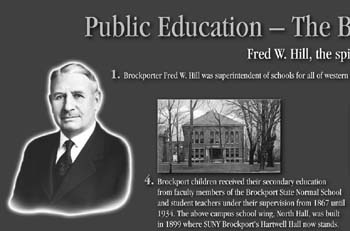
Faced with the financial needs for the construction of the new Brockport Community Museum (BCM), the board of trustees first took a step back and let their creative juices work overtime. Plans evolve from “in” to “out” But a feasibility study, commissioned by the village and paid for by a grant from the Certified Local Government Program, revealed the enormity of work involved and a cost far exceeding available funds. Suggestions came up that the property might be a better fit for a historical museum and a second feasibility study was conducted. It predicted a cost of $2.7 million for the physical conversion alone. In order to house the museum, the building needed a new roof, new windows, a second floor, a spiral staircase - the needs were overwhelming, according to BCM Board President Bill Andrews. At the final tally, the estimated total for the creation of the museum, from renovation to artifact collection to staffing, was set at $4 million. That was when the board brought in Christopher Clarke, a freelance consultant provided courtesy of a grant from the Upstate Historical Alliance. Working in tandem with the board and swapping ideas with Andrews, Clarke came up with the idea for bringing the museum out of the confines of a set location and into the public arena. The idea took hold and Andrews dubbed the project the Museum Without Walls, Brockport’s around-town homage to village history. Obviously, the capital outlay for this alternative plan was much less intimidating, and the project shifted from speculation to reality. Now it was simply a matter of logistics. Taking the museum outside: Artifacts Turner served for more than ten years as director of the Emily L. Knapp Museum of Local History on State Street. “Although it’s a fun location, much like Grandma’s attic,” says Turner, “items on display are too numerous and (not) available for people to touch (without) risking damage and theft.” In addition, the collection is not readily accessible. Tucked away on the second and third floors of the Municipal Building at State Street, it is not handicap accessible, and the steep stairways discourage the less mobile. The BCM committee thought to ease the burden of this hidden gem by assuming possession of the artifacts and relocating them throughout the community. Since the Charter laws prevented the BCM from simply moving the entire collection to a different location, the board hit on the idea of “leasing” some of the artifacts to sponsors throughout the community who would provide the space for an exhibit. The first of these exhibits, on the theme of Manufacturing in Brockport, is already set up in the Museum Room of the Fred W. Hill Elementary School. On display are products and models from manufacturers such as the Dorothea Doll Company and about inventor of the corn husker, Aaron Palmer. They also have a salesman’s model of a “Triumph” reaper, a Capen Piano from Brockport Piano Mfg. (1892-1920) and a free-standing Grandmother Clock. Andrews and Turner curated the exhibit, gathering artifacts from Andrews’ private collection and the Knapp Museum. Brockport School District carpenter Allen Hanson prepared the two glass-topped display cases for the smaller pieces; and Andrews wrote up the descriptions. Plans for public viewings and tours have not been established. Future themes for the artifact displays may include: Home Life, Canal Life, Clothing, Farm Implements, Local Personalities and Education. Taking the museum outside: Signs “We’re calling them interpretive signs,” said Andrews. Physically, these signs resemble rectangular plaques, and will either be mounted on a pedestal or directly fastened to the facade of a building. Each sign provides details about events, locations and people from Brockport’s history grouped according to a theme. Future themes for the signs include: Public Education, Higher Education, Firefighting, Downtown Churches, African Americans, Canal Commerce, Women, and Cultural Life and Entertainment. Based on the theme of the sign, the board seeks out its relative sponsor in the community. The sponsor provides the cost of production for the sign and pedestal (if required) which peaks at about $1,000, according to Andrews. Both museum and sponsor then work together to decide on the location of the sign and the date of its dedication. The dedication of the first sign, on the theme of public education, sponsored by the A.D. Oliver Middle School, is slated for some time in October and will most likely be installed in front of that school. Taking the museum to cyberspace Board member Pat Baker hopes that the site will become the interactive mainframe for the Museum Without Walls. With enough collaboration, she notes, the site could unify the project and broaden its reach into the surrounding communities. “We’re hoping that the website will encourage people to get out and see the real thing,” says Norm Frisch, who works on the exterior design committee of the BCM. In its ideal form, says Baker, the website would include individual photographs of the artifacts and signs with more detailed information, an events calendar and possibly even lesson plans from local history teachers. “As a newcomer to the board,” says Baker, “I have found everyone connected to the Museum Without Walls to be highly enthusiastic and very dedicated to making this project work. What is envisioned is creative, community friendly and doable.” Baker is secretary of the Brockport Rotary Club, as well as editor of its newsletter. “I’m hoping that the project will spur interest in the community,” says Brockport Village Manager Ian Coyle. “The Museum board is getting their work out there to the public, making it more accessible and enhancing what we already have at the Museum.” September 24, 2006 |
